
West Chelsea Contemporary is a world-class gallery offering museum-quality art in Austin, Texas, and New York City, focusing on 20th century and contemporary art predominantly in American, Asian, and European post-war movements. West Chelsea Contemporary opened in October of 2020 under the direction of Lisa Russell, who has operated this gallery since founding Russell Collection in 2002. With this gallery rebrand, her vision is for West Chelsea Contemporary to satisfy the evolving demographic and style of Austin’s culture by showcasing everything from mid-career and emerging artists to legends like KAWS, Yayoi Kusama, Keith Haring, Shepard Fairey, Andy Warhol, Blek Le Rat, Mr. Brainwash, Fiona Rae, Roy Lichtenstein, Takashi Murakami and more West Chelsea Contemporary clients are assisted by an expert staff dedicated to providing the highest level of service
NEW
YORK CITY - CHELSEA
231 10th Ave New York, NY 10011
646.590.0352

Monday - Wednesday 10am - 6pm
Thursday - Friday 10am - 8pm
Saturday 10am - 6pm; Sunday 12 - 6pm
AUSTIN - DOWNTOWN
1009 West 6th Street #120 Austin, TX 78703
512.478.4440


Monday - Wednesday 10am - 6pm
Thursday - Friday 10am - 8pm
Saturday 10am - 6pm; Sunday 12 - 6pm
WCC.ART @WCC.ART SALES@WCC.ART
WCC.ART WCCGIFTSHOP.ART
08.27-09.18
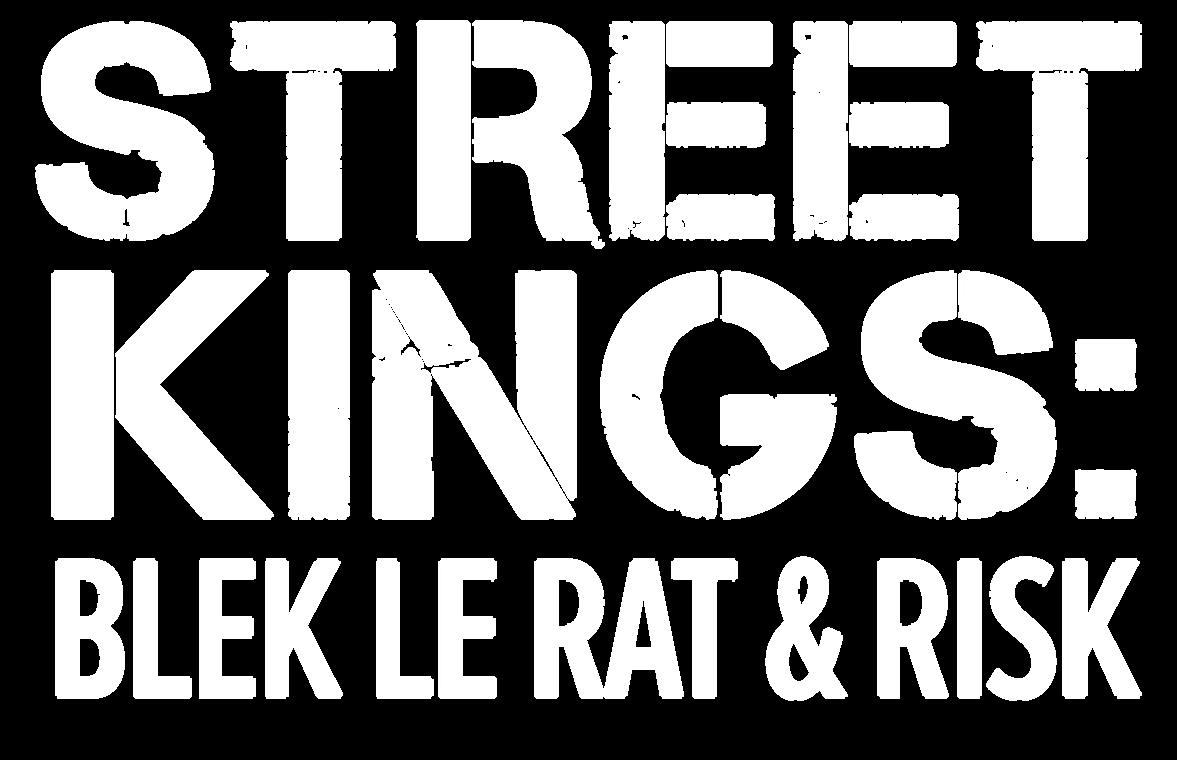


FOREWORD.......................................................................................................................................... BLEK LE RAT....................................................................................................................................... BIOGRAPHY............................................................................................................................ CAREER HIGHLIGHTS MANIFESTO OF STENCILISM ART AS INFLUENCE: MUSIC & DANCE................................................................... THE MAN WHO WALKS THROUGH WALLS...................................................... AVAILABLE WORKS......................................................................................................... RISK BIOGRAPHY............................................................................................................................ CAREER HIGHLIGHTS....................................................................................................... BUDDHA................................................................................................................................... NEON FACE YOUR FEARS........................................................................................................... RISK & ROLL.......................................................................................................................... AVAILABLE WORKS......................................................................................................... WCC x ON THE WALL 1 2 - 48 3 5 7 - 11 15 34 - 35 12 - 49 50 - 91 51 53 66 - 77 78 - 89 90 - 91 92 - 101 54 - 101 102 - 106 INDEX
FOREWORD

Street Kings: Blek Le Rat + RISK highlights two masters, each who have catalyzed a movement within their respective international homebase Paris and Los Angeles. Both Blek and RISK have a storied history within the street art movement By pioneering innovative techniques, these artists have garnered international acclaim and acceptance. French artist Blek Le Rat visited the New York scene in 1971, where he was inspired by the WildStyle graffiti subculture and the impulsive, alleyway works of Richard Hambleton godfather of street art Returning to Europe in 1979, Blek drew on his degree in printmaking and his newfound appreciation for urban art, integrating the ethos of graffiti with the practicality and refinement of stencil-based design. RISK, also known by the monikers of Risky and RiskRock, moved to LA in 1982 at 15 years old By 1989 he became one of the first LA-based taggers to adorn New York subway cars when he traveled to the epicenter of graff.
Synonymous with stencil art, Blek the founder and father of the movement pioneered the medium and paved the way for Banksy, who accredits the artist as his biggest inspiration. In his studio works, Blek uses the same large-format stencils he applies on the street and builds the surface of the canvas to be rough and cracking as it would be in situ RISK’s use of car paint and surfboard resin creates a unique metallic finish, highly desirable and aligned with the finish fetish movement in LA. From painting on a Boeing 777 to creating ‘metallic tissue’ panels from recycled spray paint cans, RISK’s practice continually pushes boundaries and embraces new media
Each artist takes inspiration from their surroundings and continues to have an active studio practice. Their imagery is relevant to the immediacy of their lives RISK painting metaphors for his personal journey and collaborating with well-known musicians, and Blek recreating the French lifestyle with spray paint Their identifiable styles denote each graffiti artist as masters of their craft.
Like most artists who pave the way for the next generation, Blek Le Rat and RISK continue to develop their techniques and create new work that showcases their mastery. Street Kings reveals their next chapters on canvas, in neon, and across a range of media from metallic tissue to plane doors
1

French, b. 1951 BLEK LE RAT
Blek Le Rat, born Xavier Prou in Boulogne-Billancourt, Paris, was one of the very first graffiti artists in Paris and has been described as the “Father of Stencil Graffiti” Blek was first introduced to graffiti during a trip to New York City in 1971 where he was inspired to bring the style back to Paris, adapting the stencil as a more fitting technique for French architecture. He is best known for stenciling a giant graphic image of a rat all over Paris in the early 1980s, which to him symbolized both freedom and the dissemination of art through the city as if it were the plague Blek, who has influenced generations of urban artists around the world, boasts a subtle social commitment and considers his images as a gift he gives to the city. His works often represent solitary individuals that can be encountered in the urban space–women, children, the elderly, and a diverse range of contemporary characters. In a desire to bring the people of the city closer to art, he quotes the great classics such as Caravaggio, Michelangelo, and Leonardo da Vinci. “I would like to bring the characters out of museums to return them to the people of the city ” His street art has appeared in cities across the world, and he has exhibited in New York, London, Los Angeles, Melbourne, and beyond.
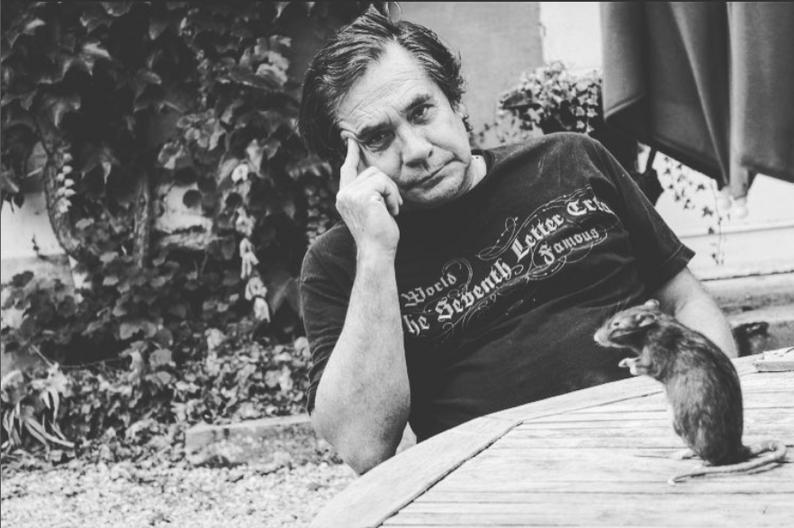
3

Travels to New York where he is influenced by burgeoning graffiti scene
Begins spray painting rats on the streets of Paris
Graduates École des Beaux-Arts where he studied Fine Art & Architecture
Sees Richard Hambleton's "Shadowman" in Paris inspiring him to create life-sized stencil designs
First Solo Exhibition | Peinture Sauvage, Galerie Saint Claude, Paris
Participates in the first gathering of the graffiti and urban art movement in Bondy, France
1991 Blek Le Rat from Paris to Tokyo, Takarshi Gallery, Tokyo
2002 Blek Was Here, Urban Art Gallery, Berlin
Blek Le Rat in London, Leonard Street Gallery, London
Participates in Cans Festival, Waterloo, London
Art is Not Peace But War, Subliminal Projects Gallery, LA
La Ciel Est Bleu, La Vie Est Belle, Metro Gallery, Melbourne, Australia
Escaping Paris, Curated by DK Johnston, The Quin Hotel, New York
Reaches auction record high of $93,610

Propaganda, Wunderkammern, Milan, Italy
The Man Who Walks Through the Walls, Galerie Kronsbein, Munich, Germany
Featured in Saving Bansky documentary Ratical, Vertical Gallery, Chicago IL
1971 1981 1982 1983 2006 1985 2008 2009 2014 2016 2017
5

MANIFESTO OF STENCILISM
I saw wildstyle graffiti for the first time during a trip to New York in 1971 There was an incredible profusion, in the subway, on the walls surrounding basketball courts, graffiti drawn in marker, nestling signatures surmounted by a crown, spray-painted lettering, filled with swirls and colors, everywhere I looked I was so intrigued by these illuminations I remember asking the inevitable question: "What does all this mean? Why are these people doing this?”
Unfortunately no one could give me a satisfactory answer, except that it was the work of thoughtless and irresponsible people. I found that people engaging in graffiti were generally known as a “dirty bunch,” and called such by John Vliet Lindsay, mayor of NYC from 1966 to 1973 At the same time in Paris, this means of expression was still in a latent state Of course, there were the political and social demands scribbled on the walls of the city in 1968, and of course, we had addressed the subject through posters of protest created in the social workshops at the École des Beaux-Arts, but there was yet to be a movement of artists investigating the urban landscape and acting out artistically within it Yet the street art movement had already existed in the United States since the mid-60s when dozens of artists, condemned to urban anonymity, sounded the alarm, writing their tags on walls, in spray paint or marker.
The graffiti I saw in New York remained firmly planted in my memory though acting out my own graffiti took ten years to hatch. Studying fine arts and architecture during the 70s at the École des Beaux-Arts in Paris familiarized me with the techniques that would come in handy later, in my work on the street I became well versed in the techniques of etching, lithography, and screen printing, and all of these methods, along with the study of architecture at the Architectural Teaching Unit #6, made me aware of the intricacies of planned urban space It was also in the early 70s that I was largely influenced by David Hockney, who had a major exhibition near the École des BeauxArts in Paris. I can say that his work is the most impressive thing I had ever seen in my life. The following year Hockney made a film titled The Bigger Splash, in which he uses oil to paint the image of one of his friends on the wall of an apartment; the image has never left my mind. I thought this film was so important to the history of art that I watched it over and over, as many as ten or fifteen times.
7
In 1980 my friend Gerard and I worked at an adventure playground in the town of Les Ulis, designed for pre-teens during the school holidays I was working as a volunteer on this adventure playground It was a place inhabited by young children who came to meet other children without the world of adult authority intruding upon their games. The playground was located directly behind a supermarket and people the children frequently came and went between the two Among the discarded trinkets from the store, one could regularly found find paint cans that were removed illegally from the store and used to paint and repaint the cabin in which we kept our equipment.
Big, dripping Frescos following no particular style appeared throughout the year and were routinely painted over. Gerard and I were moved by each and every creation and we decided to get some spray paint of our own out of the desire for modernity. We had caught the bug The capital was ours, we needed only to act The first time we did graffiti, in October 1981, Gerard and I tried to reproduce the American-styled graffiti on an abandoned wall in the fourteenth arrondissement of Paris, on Thermopylae Street. It was a fiasco! None of the imagery turned out well. I then suggested we make stencils a very old technique that was an ancestor to screen-printing and later used by far-right Italian political factions in their propaganda. After remembering the stenciled image of the Duce helmet I’d seen in the early 60s, a remnant of WWII, during a trip I took with my parents to Padua, Italy We finally had the technique and the equipment, we had only to act
The streets of Paris afforded us ample space to work in, and the practice of graffiti was completely unknown at that point, so the roaming police rarely disturbed us unless they wanted to know what we were doing and whether our agenda was political We answered: “No it’s art,” and the game was won. Gerard and I used the name BLEK in reference to an Italian comic book that we read in our childhood called Blek le Rock. We chose to use a pseudonym because we decided we wanted to remain anonymous as a way to challenge the locals.
Who were the authors of these little rats, these bananas, the little running men, and all the little stencils that we made during the day and sprayed come night throughout the fourteenth and the eighteenth districts of Paris?
Over time, our nocturnal outings became more and more frequent On December 31st in 1981, we decided to stencil the temple consecrated to Modern Art: the Centre Georges Pompidou.
8
That night in the freezing winter cold, we painted lots of rats, tanks, and small figures on the Centre Pompidou, a place where people come from all over the world to worship art Museum guards came out to ask what we were doing there As when we had been questioned by the police, we answered “art,” to which the guards responded with a slight smile. In 1983 the duo that made up BLEK separated when Gérard developed other interests he wanted to pursue Upon finding myself without a partner, I decided to adopt Blek le Rat as my nom de plume. It is through the name that we are recognized, tracked, the image becomes a support to the name, the name that told me: You exist for thousands of people you do not know and you will never meet, but you exist in this closed world of urban anonymity
I felt empowered to paint and avoid the middlemen who would judge my work with their values I had found liberty within the anonymity of my work, a form of freedom I was alone in the city and the city was mine After a night spent painting, I would pass by my walls, again and again, sometimes standing for hours looking at my work and the people passing by. The smallest glance they gave my graffiti filled me with joy. My enthusiasm had me creating more and more ephemeral images, with the wear and tear of painting on the streets, individual stencils don’t last very long. Dried paint eventually forms a crust around the stencil’s edge and the cutout sections close up after being sprayed several times New stencils always have to be made; the more I worked, the better my technique became, and with improved technique, the easier it was to do better work faster.
In March of 1983 after mastering my technique, I came up with the idea of making a lifesize stencil I found a photo of an old man wearing a cap in the newspaper Libération Taken in Northern Ireland, the photo suited my needs perfectly. This character would stroll through the streets of dozens of cities in France, left as a hint of my passage. He became known as “Buster Keaton,” “Charlie Chaplin” and “the old man,” and eventually took on a dimension that I had not originally intended. His figure became famous in an unexpected way: The public was enamored with the image, and the photojournalists were in a frenzy to capture each painting that I put up
During that time, I would often stumble onto printed photographs of my figure in various newspapers beside articles that were unrelated to graffiti. Because this venture was so successful, many other life-size stencils followed, all of which resembled me in some way and with whom I felt an affinity
9
There was Tom Waits, a little boy in short pants, Andy Warhol, Marcel Dassault, The old Man with a Stick, a woman and child, a Russian soldier that I painted at every exit of the main périphérique around Paris, President Mitterrand, a faun, Joseph Beuys, a man simultaneously running and screaming, two dogs in mating, and a woman in garter belt stenciled on the entrance to Serge Gainsbourg’s house and other appropriate places.
They were my characters, and I think they all resembled me somehow. They introduced me to the world like a person would introduce himself to another and when I paint my characters, I always feel as though I am leaving a part of myself on the walls of the cities around the world that I’ve visited
During the summer of 1984 stencils other than my own began to appear on the walls of Paris The first I saw were signed by Marie Rouffet and Surface Active A dialogue had been established between us and their graffiti was complementary to mine; it was as though we shared a private joke between us, which did not displease me, and aroused in me a myriad of thoughts about this new language, of hieroglyphics that we had in common
While stencil graffiti flourished in Paris the surreptitious repression (that was the criminal justice system) began to stretch out its feelers The cops were becoming more aggressive and I experienced my first arrest in Les Halles It was my first time in police custody, my first police report, my first questioning by a detective. Fortunately for me, this detective was a fan of comic books and did not transmit the report to the prosecutor Nothing came of the arrest, but the fear of being caught became very real soon after and has never left me from the end of 84 From that moment on, I studied the habits of the cops, their comings and goings, which days they had off and the times they made their rounds. I learned to hide my equipment under cars, to have friends watch the streets where I was going to work, and finally, I got used to taking more precautions as my activities became illegal and the penalties increasingly severe. Despite this unbearable game of hide-and-seek, the desire to express myself, to paint, was so strong that the tension was transformed into an endless flood of creativity when the time came to work For there is no greater joy for me than to work on the streets in the depths of a winter night when my hands freeze and the heart burns in fear.
Throughout the years, I continued to be anxious about the possibility of incarceration It was in October 1991 when that fear became a reality I was ordered to appear before the Parisian court for the crime of damaging property belonging to others.
10
I was again fortunate enough to come across a judge who loved my work and said: “I can not condemn you for this, it’s too beautiful,” after looking at a photo of my stencil my lawyer had given him

Urban artists have simply the intention to speak via images; these images are intended words to the community: paroles of love, hate, paroles of life, and death It is a kind of therapy; therapy that showcases elegance, refinement, and attempts to fill the gaps of this horrible modern world, to cover urban areas with images of joy and catch the eyes of passers-by in the early morning as they begin their day But the authorities are implacable in their reaction to street art, declaring war on graffiti, and using the law to hold over the heads of these young artists a punishment that is not equal to their misdeeds. They threaten street artists with huge fines as if our cities have more to fear from unsanctioned artwork than drugs
The immense desire to paint and to express ourselves through our imagery has been so strong that urban artists around the world have made this movement the most important of the century, with its profusion of images and the number of people who participate. One has only to look at the scope and breadth of our work across the globe to see how far we’ve reached and the authenticity of our messages. There is no place
Blek Le Rat
Rat, 2022
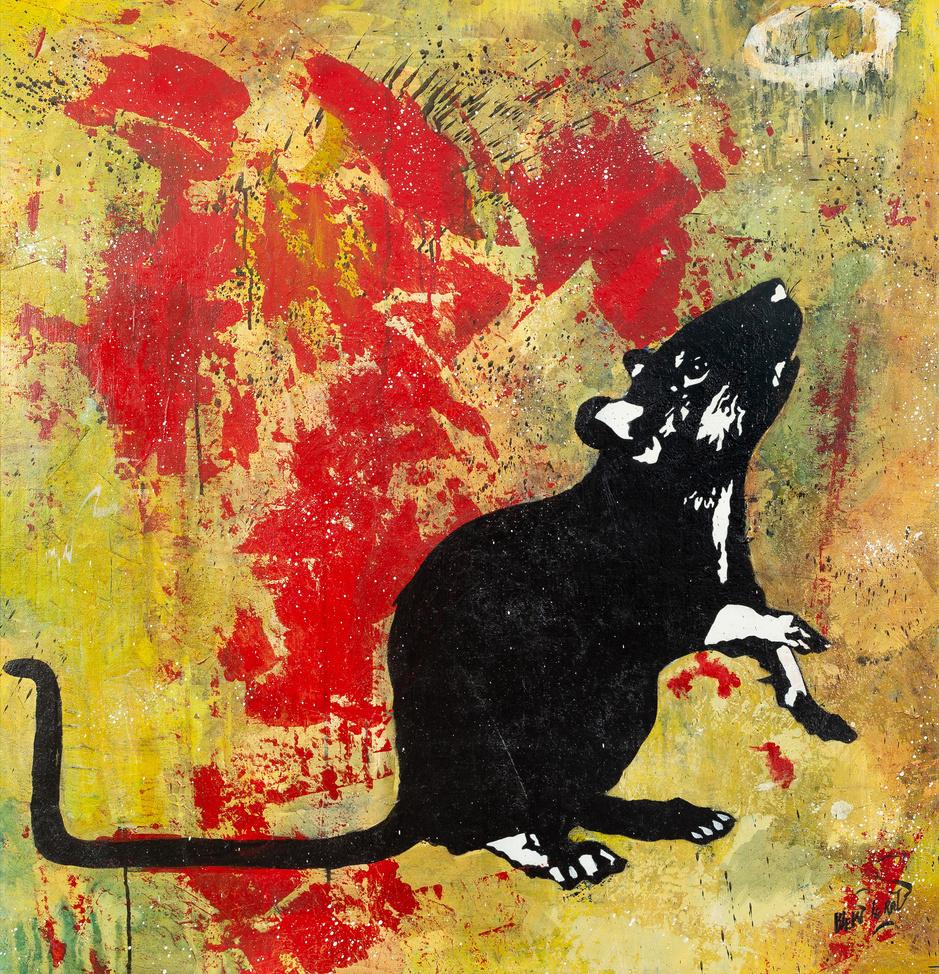
Acrylic and Aerosol on Linen
40 x 40 in
Blek Le Rat

Crooner With Bird, 2022
Acrylic and Aerosol on Linen
45 x 63.5 in
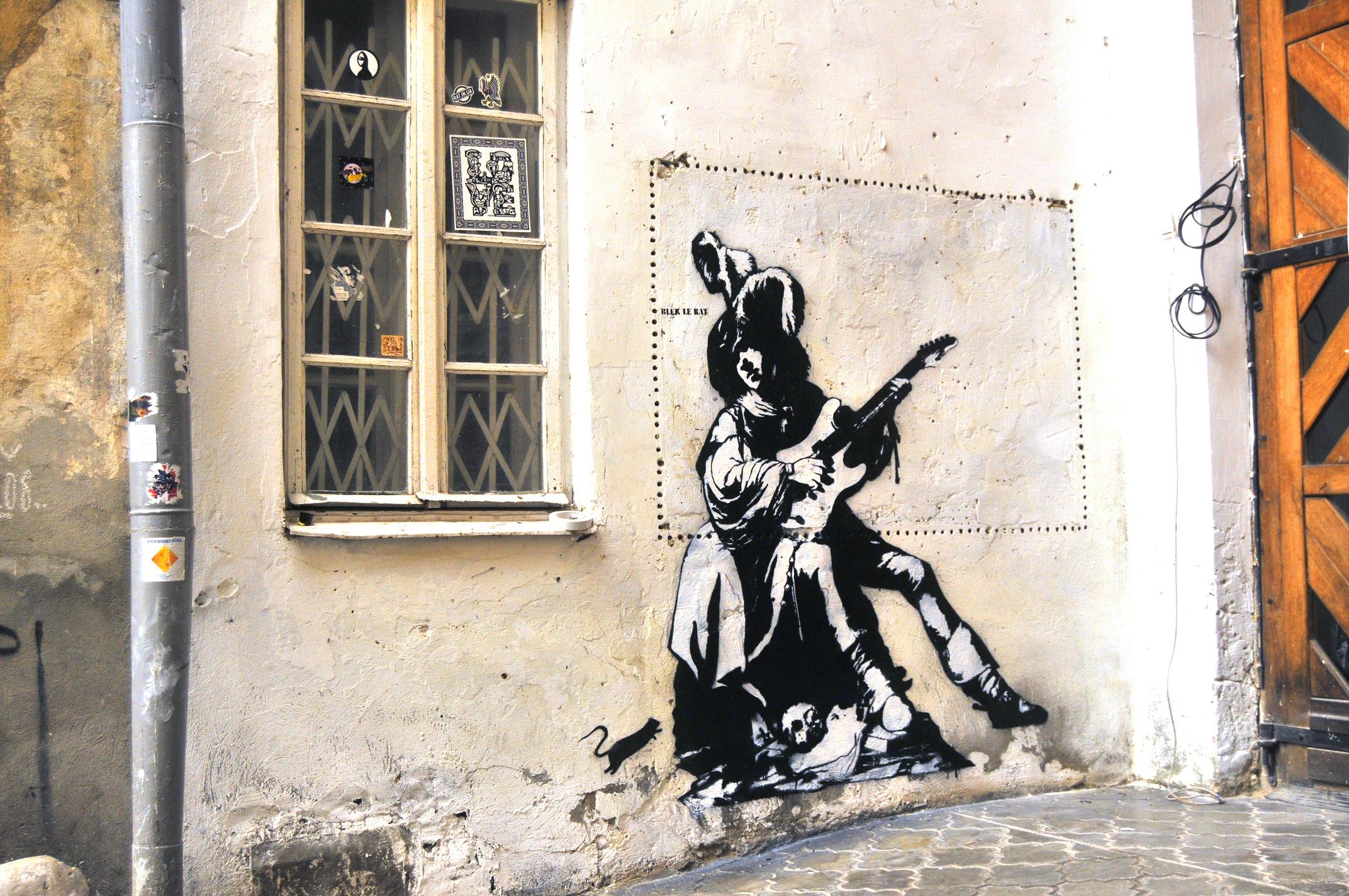
ART AS INFLUENCE: MUSIC & DANCE
Among Blek Le Rat’s diverse range of subjects are a host of works featuring musicians, dancers, and composers. It is this collection of work that the artist considers his highest form of art
With the aim of bringing “characters out of museums to return them to the people of the city,” Blek often takes inspiration from compositions of the old masters such as Caravaggio, Michelangelo, and Leonardo Da Vinci. The artist’s deep fascination with cultural production and engagement with other modes of artistic expression is evident in works of this nature. Blek often incorporates ironic juxtapositions, merging classical figures with symbols of modernity, as in his Renaissance musician who sits playing the electric guitar
During a trip to South America ten years ago, Blek encountered flamenco and tango dancers in the streets of Argentina. Inspired by their balletic movements and the freedom of their expression, Blek began incorporating dancing figures into his repertoire of characters The artist has explained, "Dance makes me forget the laws of gravity." As a master of stencil design, Blek's dancers beautifully translate the experience of fluid motion into a single moment. When viewed together the works appear as though they are gracefully gliding along the wall.
15
Blek Le Rat
Renaissance, 2021
Acrylic and aerosol on linen
51 1 x 38 5 in
16

Blek Le Rat
3 Ballerina, 2021
Acrylic and aerosol on linen
51 x 39 5 in
18

Blek Le Rat
6 Dancers Colour, 2021

Acrylic and aerosol on linen
63.5 x 51 in
Blek Le Rat
Great Dancers, 2022

Acrylic and aerosol on linen
78.5 x 78.5
Blek Le Rat
Danseuse Couleurs, 2022
Acrylic and aerosol on linen
63 5 x 51 in
22
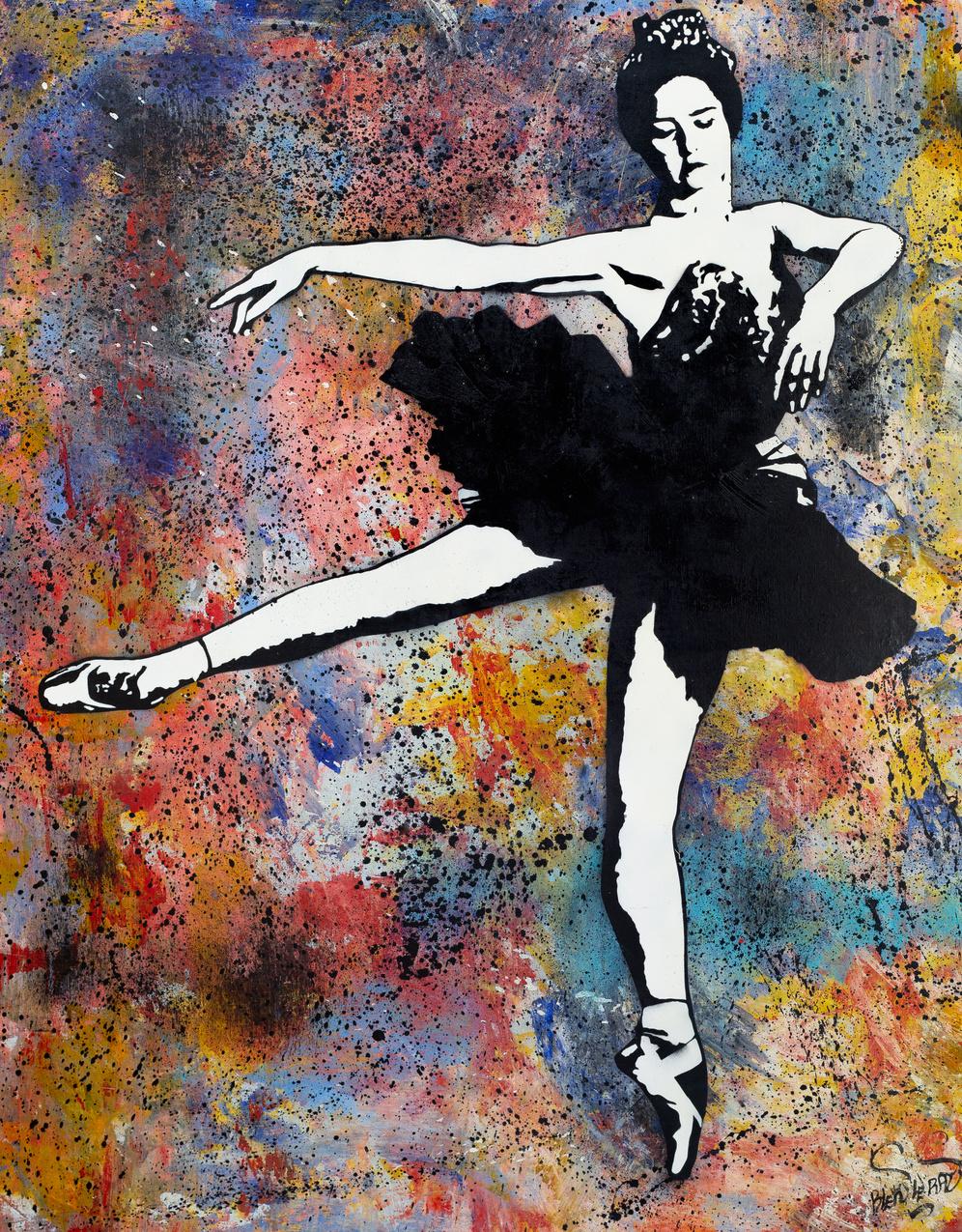
Blek Le Rat
Danseuse Blue, 2022
Acrylic and aerosol on linen
63 5 x 51 in
24

Blek Le Rat
Sweet Dreams Red Gray, 2022
Acrylic and aerosol on linen
63.5 x 63.5 in

Blek Le Rat
Young Picasso, 2022
Acrylic and aerosol on linen
39.5 x 39.5 in

Blek Le Rat
Music to Live 2, 2011
Acrylic and aerosol on linen
81 x 53 5 in
28
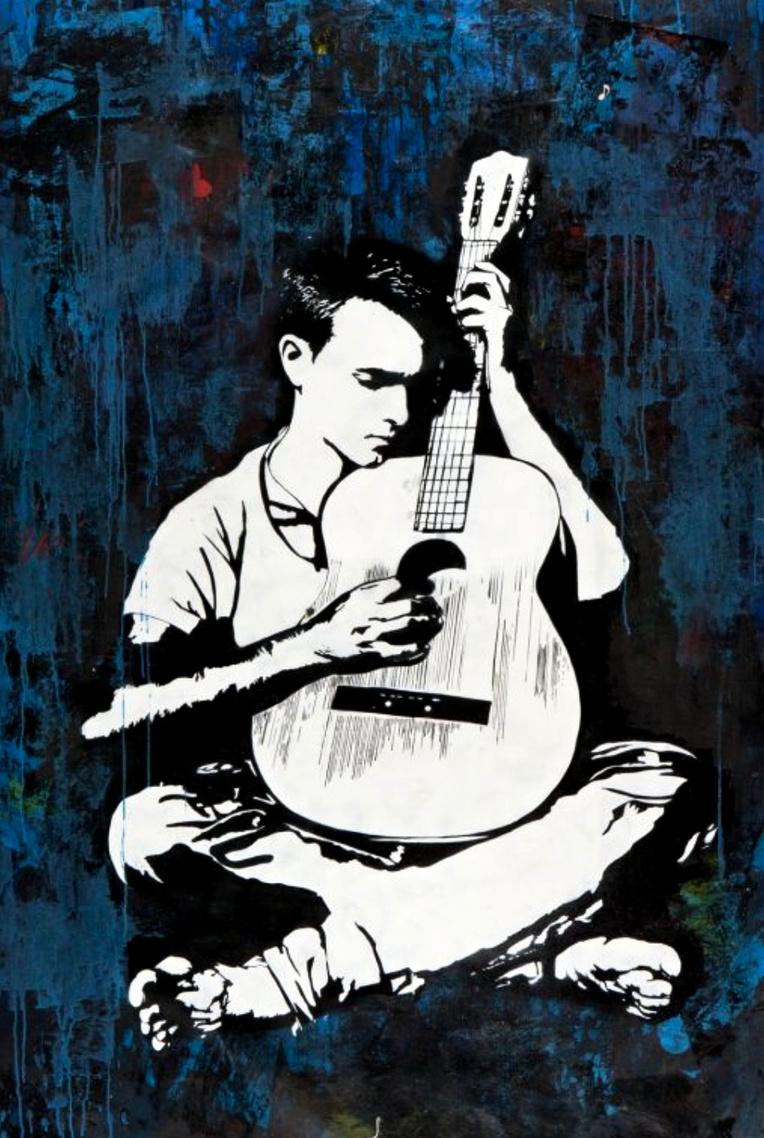
Blek Le Rat
Music to Live 1, 2011
Acrylic and aerosol on linen
81 75 x 56 25
30

Blek Le Rat
Pantomine 2, 2022
Acrylic and aerosol on linen
78 5 x 55 in
32
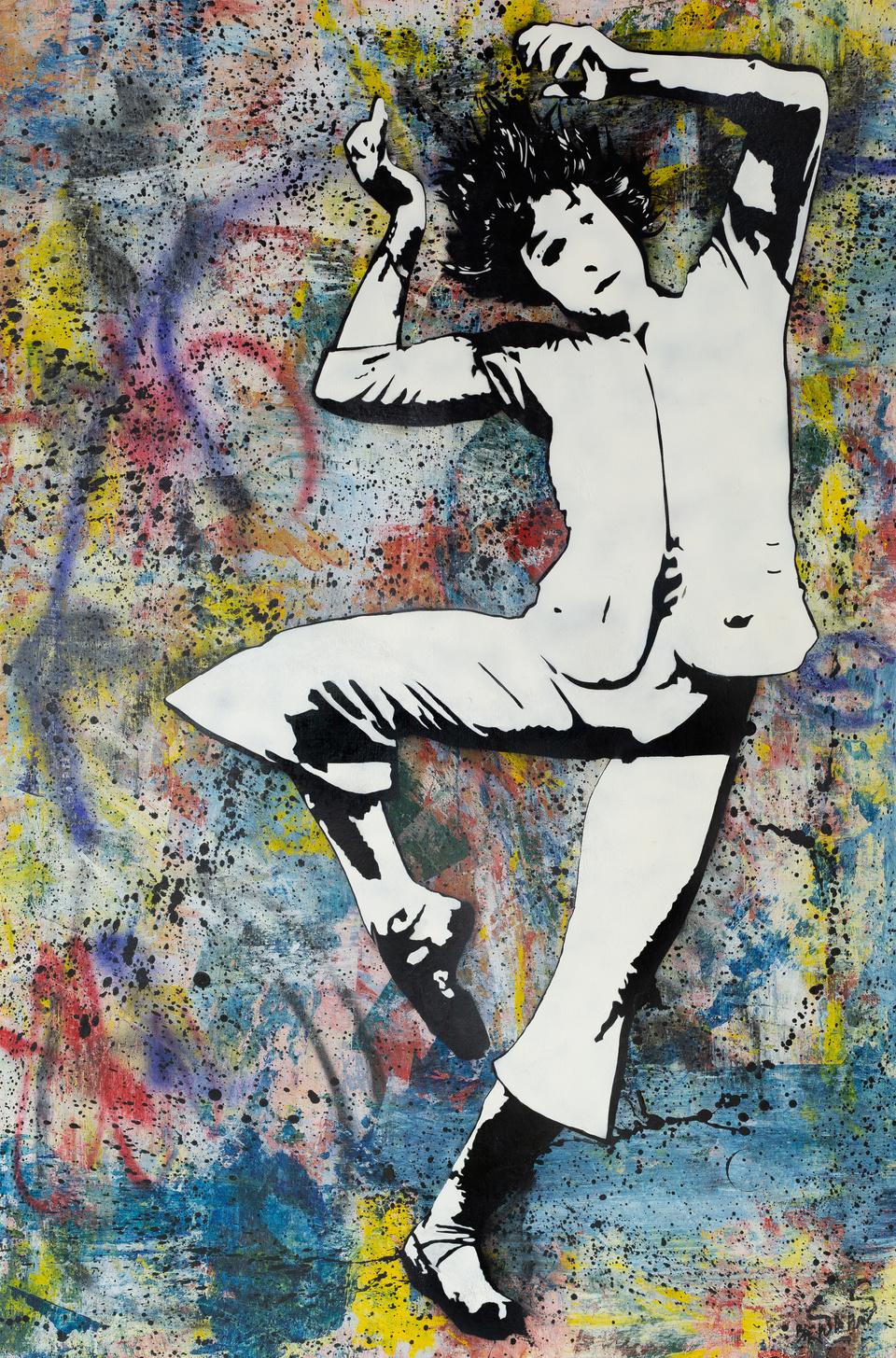
THE MAN WHO WALKS THROUGH WALLS
One of Blek Le Rat's most notable images is his selfportrait, The Man Who Walks Through Walls (TMWWTW). This character features the artist's face on the body of one of his favorite actors Buster Keaton holding suitcases filled with stencils. Blek has described this figure as a traveler who journeys around the world, perhaps an immigrant seeking a place to settle down. "He is like a ghost" Blek explains, walking through one wall only to appear on another in a new city The figure also lends itself to Blek's own mission of spreading his art widely, traveling across the world to adorn the streets of faraway places.

TMWWTW made its debut on the streets of London in 2004 and has since become, fittingly, Blek's most traveled character. He can be found on walls in London, Buenos Aires, Leipzig, Prague, and New York, among others. Oftentimes Blek incorporates the flag of the country in which he paints the character on the side of one of the man's suitcases.

Blek Le Rat

TMWWTW Black, 2022
Acrylic and Aerosol on Linen
43 x 43 in
Blek Le Rat
Joie de Vivre, 2022
Acrylic and aerosol on linen
39.5 x 39.5 in

Blek Le Rat
Astronaut, 2022
Acrylic and aerosol on linen
63.5 x 63.5 in

Blek Le Rat
Boy With Airplane, 2011
Acrylic and aerosol on linen
79 5 x 52 x 2 in
38

Blek Le Rat

Friends, 2008
Acrylic and aerosol on linen
79 x 54.5
Blek Le Rat
Juggler, 2022

Acrylic and aerosol on linen
55 x 83 in
Blek Le Rat
Angel With Rat Red, 2022
Acrylic and aerosol on linen
63 50 x 51 in
42

Blek Le Rat
Patron of the Arts (/30), 2022
Two color screenprint on 300g arches paper
30 x 22 in
44


Blek Le Rat
White Rat (on black) (/120), 2020

Two color screenprint on 300gsm Arches paper
10 x 10 in
Blek Le Rat
Golden Rat (on black) (/120), 2020
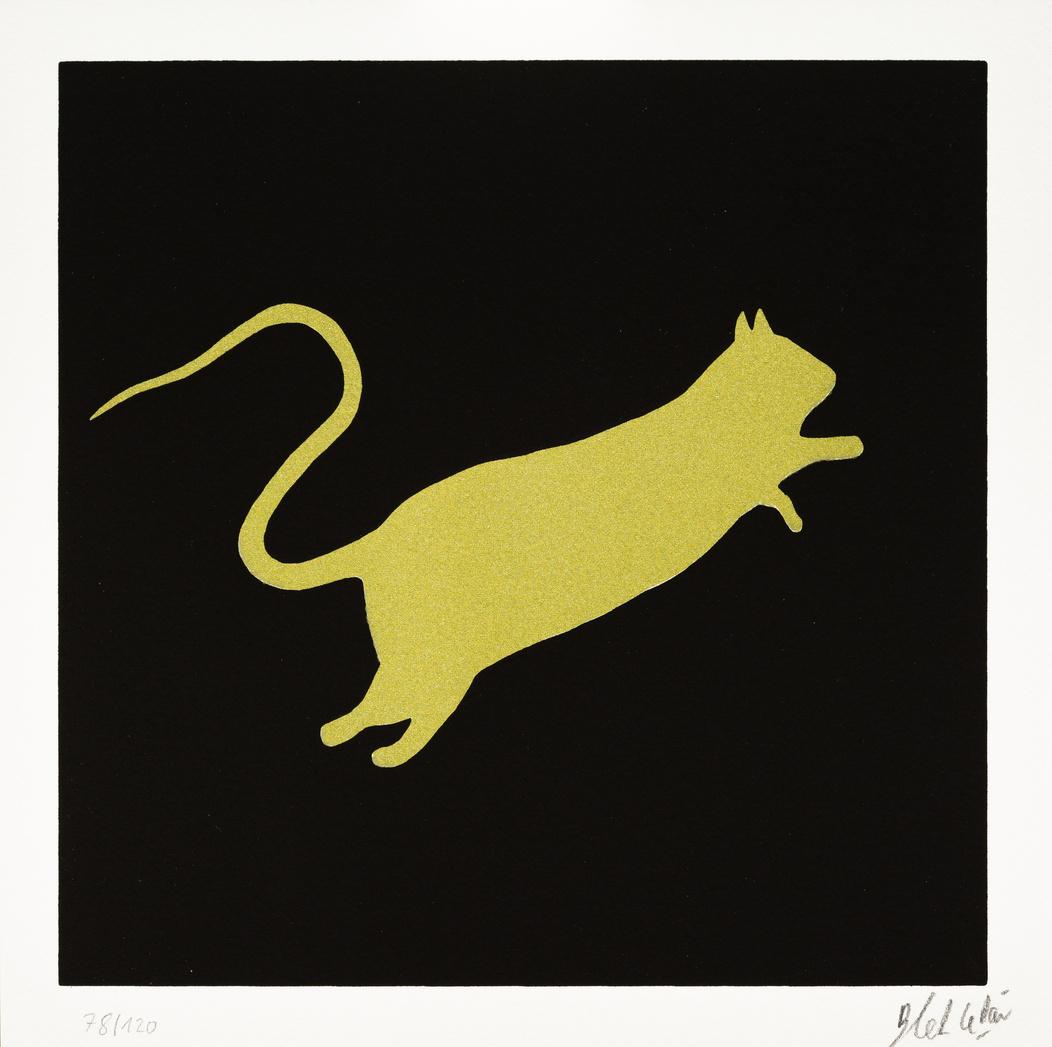
Two color screenprint on 300gsm Arches paper
10 x 10 in
Blek Le Rat
White Rat (on red) (/120), 2020

Two color screenprint on 300gsm Arches paper
10 x 10 in

American, b.1967 RISK
moved to Los Angeles with his family and made his new high school his personal canvas He has participated in a number of street art crews, most famously West Coast Artists (WCA) and the Seventh Letter. In the course of his nearly 30-year career, RISK has become one of the most influential figures for subsequent generations of graffiti artists, particularly in Los Angeles. He is also considered one of the first artists to have painted on freight trains, as well as a pioneer of “painting in the heavens” a graffiti term referring to highly elevated surfaces like billboards, rooftops, and overpasses. His art can be seen in music videos by everyone from the Red Hot Chili Peppers to Michael Jackson

51

1985 Founding member of WCA (West Cost Artists) which went on to become the premier crew for the first decade of Los Angeles graffiti

1987
Paints the graffiti background featured in Michael Jackson's The Way You Make Me Feel music video
Visits New York City and is the first LA graffiti writer to paint on NY subway cars
1989
Invited to represent the United States, alongside SLICK, at the Bridlington International Street Art Competition in the UK, which the pair won
Develops and launches clothing line "Third Rail" with SLICK and DANTE
2008
Featured in Art Basel, Miami
First solo exhibition, Twenty-six, Track 16 Gallery, Santa Monica, CA
Featured in Art In The Streets, Museum of Contemporary Art, LA
2014
2011 2018 2019
Painted the outside and inside of the iconic "Whiskey A Go Go" in LA for Aerosmith's 2014 tour with Slash
Collaborates with Travis Barker to design cover art for Blink-182 album "9"
Paints biggest mural in canada on the outside of an abandoned 74,000 square foot building
2020 Selected by NFL as one of six international artists to paint at the Super Bowl in Miami
Participates in Glasgow International biennial
Collaborates with Monster Energy to design custom can
2021 Drops first NFT collection
1988
1990
53
RISK Keep On Butterfly, 2021
Acrylic, spray paint, and crushed abalone on canvas
65 x 60 5 in
54
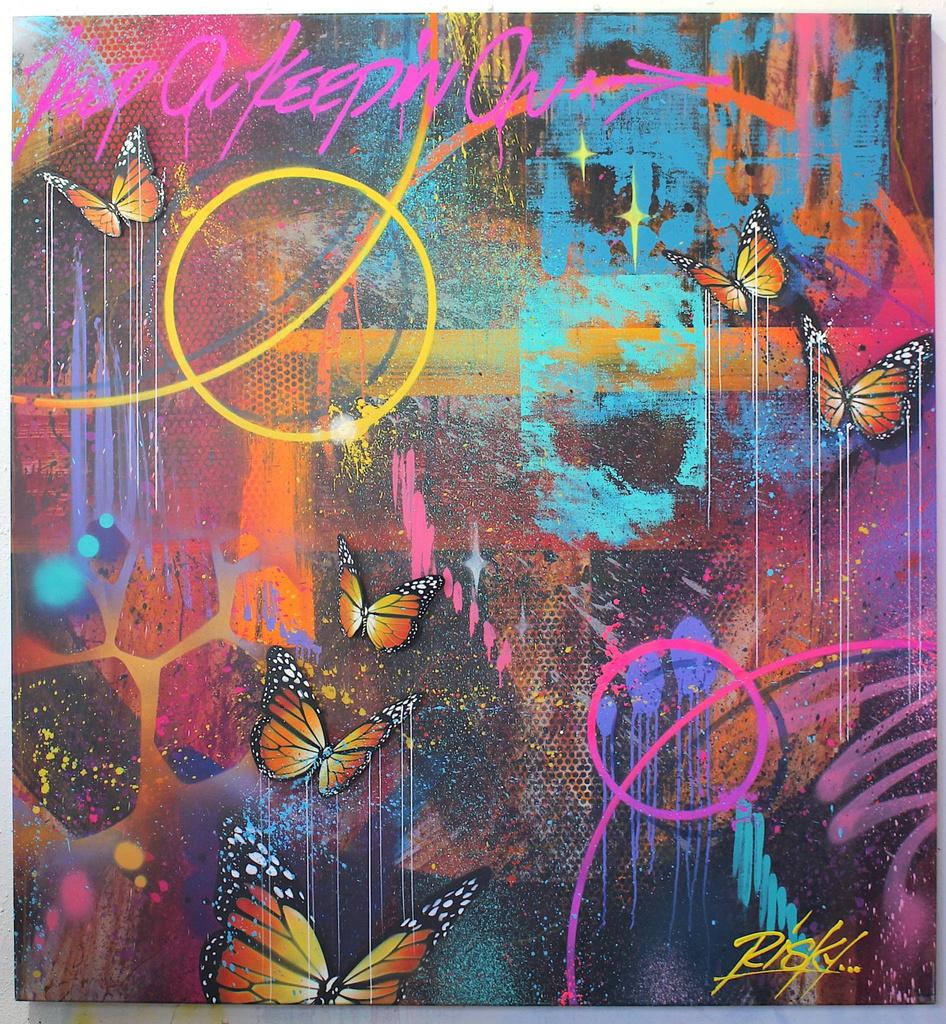
RISK
Risk Tag Relief, 2021
Spray paint and kandy car paint on recycled spray cans, license plates, and road sign panels with surfboard resin
36.5 x 53 x 3 in
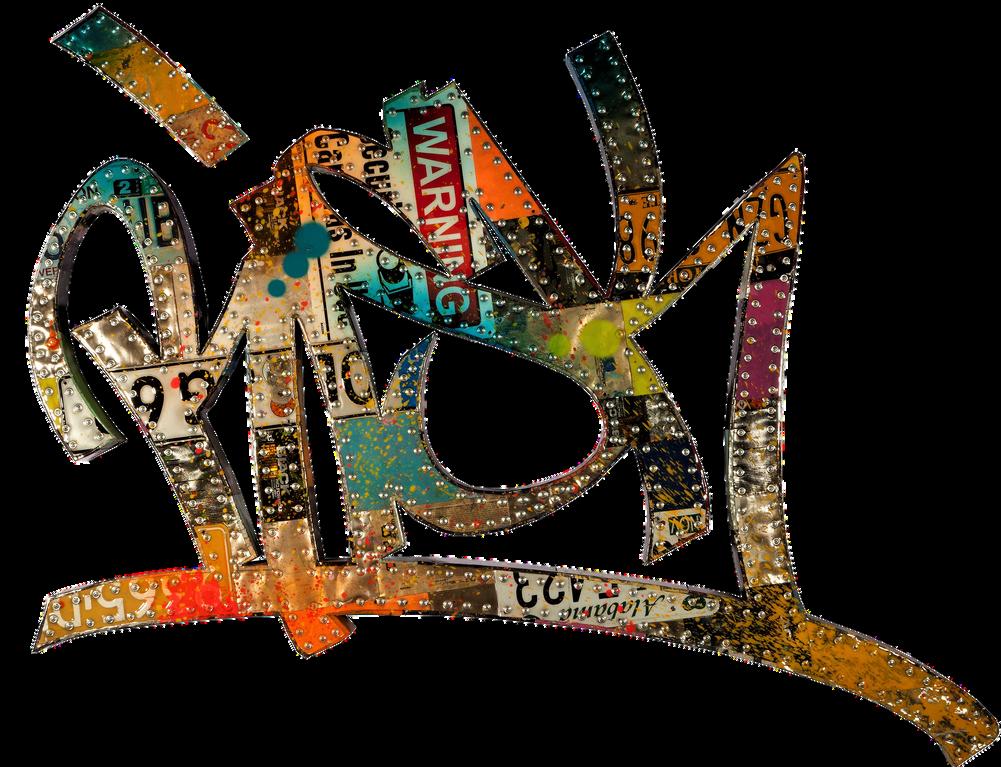
RISK
Keep on Keepin On, 2022
Acrylic, aerosol, multi-layer plexiglass on hand

woven strips of canvas
54 x 50.5
RISK
Anarch to Monarch #6, 2021
Acrylic and spray paint on Coventry rag archival paper
42 5 x 29 5 in
58

RISK
Anarch to Monarch #10, 2021
Acrylic and spray paint on Coventry rag archival paper
43 x 29 in
60

RISK
Risky Felix Head, 2022
Acrylic, aerosol, multi-layer plexiglass on hand
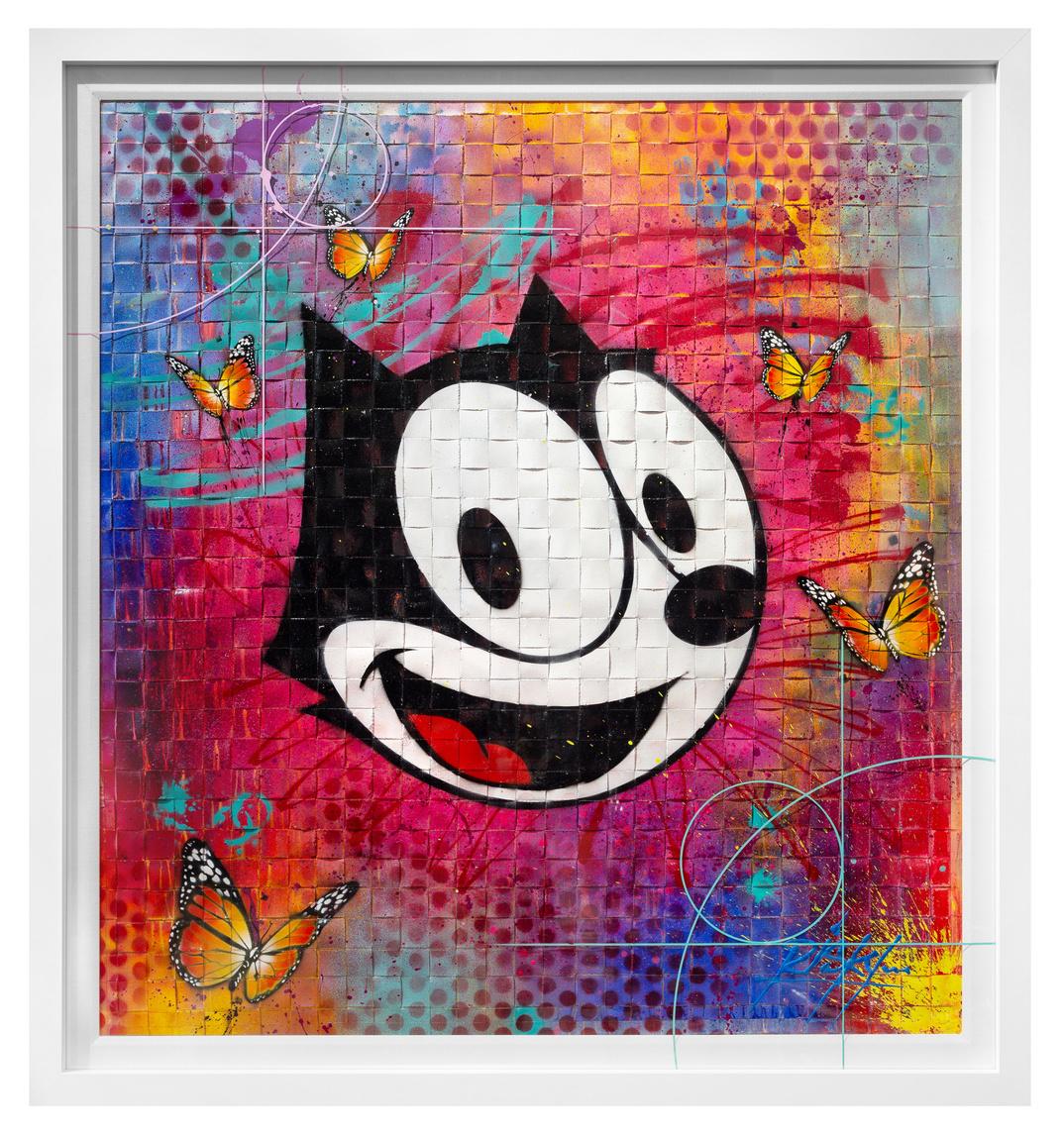
woven strips of canvas
54 x 50.25
RISK
Risky Felix, 2022
Acrylic, aerosol, multi-layer plexiglass on hand

woven strips of canvas
67 x 67 in
RISK
Wall Street Bull (Blue), 2021
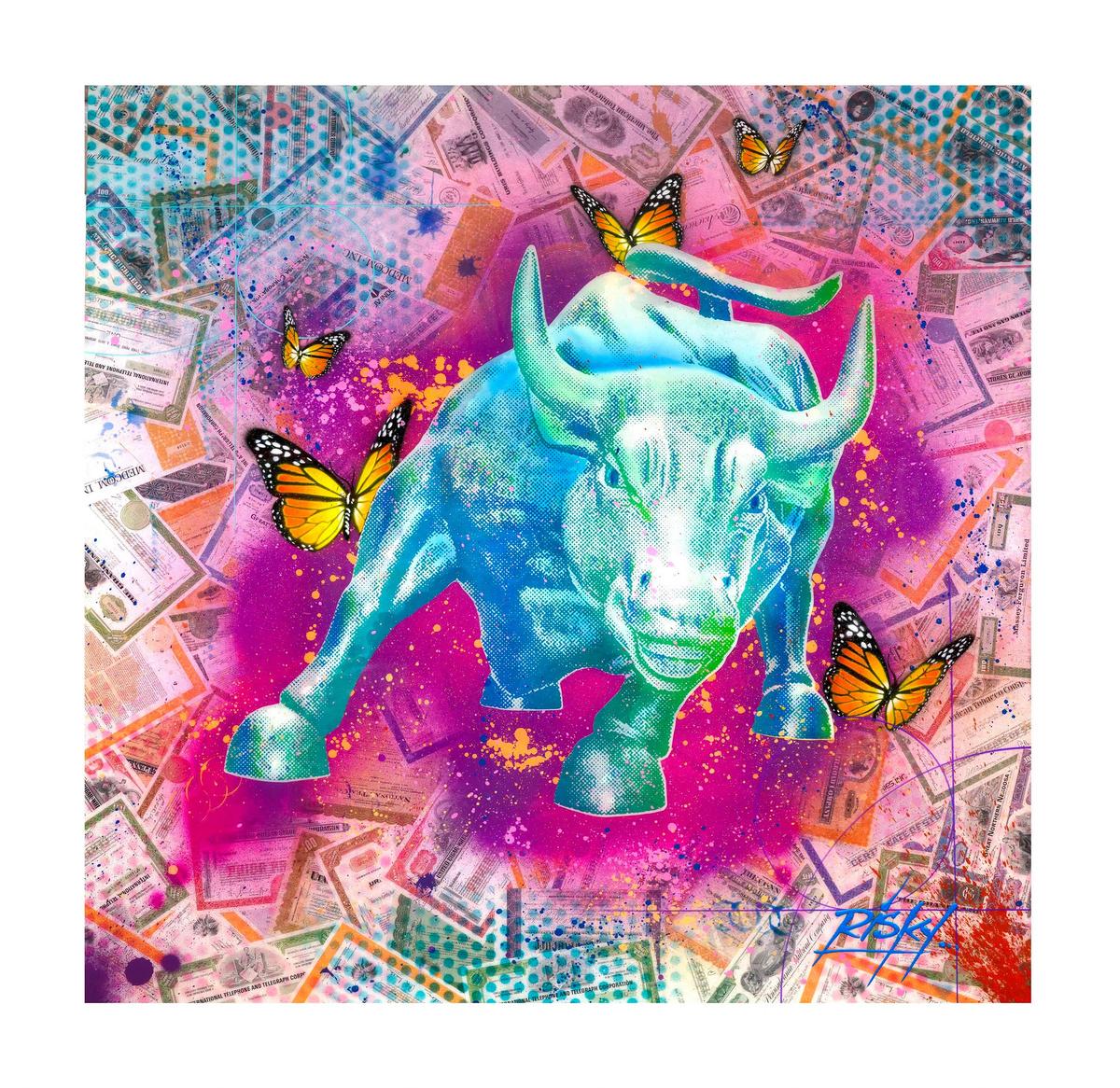
Acrylic, spray paint, crushed abalone, and surfboard resin
on wood panel with vintage stock certificate collage
60 x 60 in
RISK
My America, 2020
Acrylic and spray paint on discarded American flag
53 x 89 in


BUDDHA
RISK’s serial use of buddhist imagery was inspired by his interaction and collaboration with the late contemporary painter Ed Moses, a seminal figure in the Post-War, West Coast art scene. Before his passing, Moses introduced and educated RISK on his Buddhist beliefs which greatly intrigued the artist. Fully inspired, he went on to create a piece for Hollywood’s Shep Gordon, delving deeper into this newfound Buddhist series. RISK is a self-proclaimed “Buddhist beginner” and draws inspiration from the religion while he continues to search for an elevated state of mindfulness Many of RISK’s Buddha works, such as Peaceful Buddha (2020), embody the many juxtapositions seen consistently in the artist’s work. The Buddha represents RISK’s philosophy that people are composed of three modes of thought: right, wrong, and in-between (which he refers to as "our greater good"or "the real grey area")
67
RISK
Peaceful Buddha with Butterflies, 2022
Acrylic, spray paint, kandy car paint, crushed abalone, and surfboard resin on textured copper panel
53 x 40.5 in
68
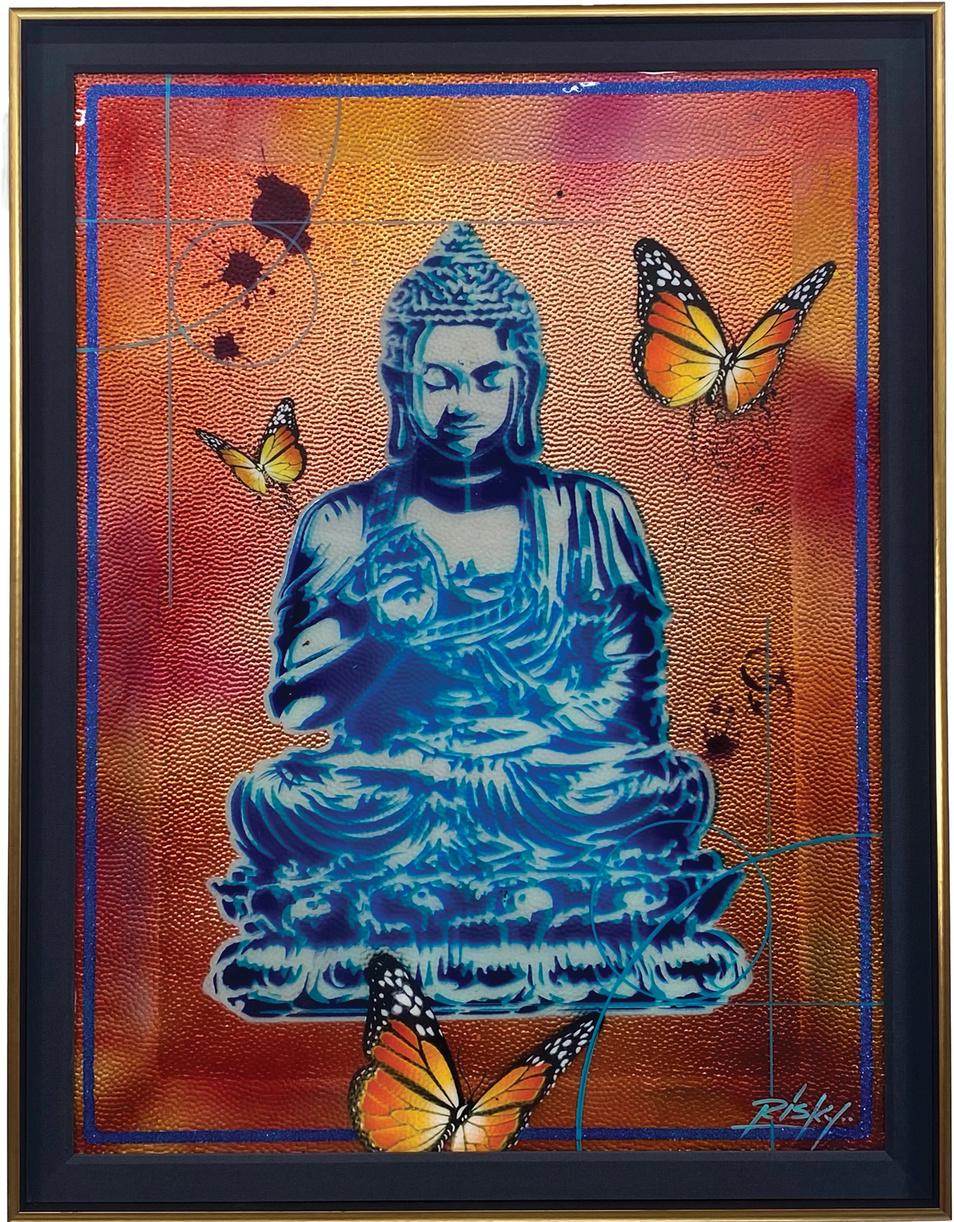
RISK
Peaceful Buddha #10, 2021
Acrylic, spray paint, crushed abalone, and surfboard resin on Coventry rag 360 GSI archival paper
44 x 29.5 in
70

RISK
Peaceful Buddha Zildjian Gong, 2021

Acrylic, spray paint, and kandy car paint with surfboard resin
39 x 39 in
RISK
Peaceful Warrior 777, 2021
81 x 50 x 10 in
 Acrylic, aerosol, and crushed abalone on door from Boeing 777 airliner
Acrylic, aerosol, and crushed abalone on door from Boeing 777 airliner
RISK
Peaceful Warrior Orange, 2022
Acrylic, aerosol, multi-layer Plexiglass on hand-woven strips of canvas
67.25 x 67.25 in

RISK
Peaceful Warrior Blue, 2022

Acrylic, aerosol, kandy car paint, crushed abalone, surfboard resin, and neon on "Metallic Tissue" panel, recycled spray cans and license plates
60 x 60 in
RISK
Peaceful Buddha Woven #1, 2021
Acrylic and spray paint on hand woven strips of Coventry rag
archival paper with burned edges
58 x 36 in
76


NEON
To RISK, neon is the most versatile form of artistic representation in contemporary art. Although the majority of contemporary artists use it to convey text, he believes its representational purpose is equally as strong. Neon is a gateway between scientific principles and artistic expression, integrating electrical technology, creative design, and fundamental concepts of physics and chemistry. RIsk has been devoted to art in electric media, exhibiting electric and kinetic fine art for over 25 years. His fascination with neon began in one of his early studios where he met a neighbor who made neon signs Risk took hundreds of random scrap pieces and strung them randomly together from fishing wire. He began clustering groups together by color to evoke emotion or cast a mood. Enamored with the glow of neon, RISK believes the pieces take on two lives; one with neon on and another with the lights off
79
RISK ATX, 2022
Aerosol, kandy car paint, crushed abalone, surfboard resin, and neon on metallic tissue panel, license plates, road signs, recycled spray can panel 45 x 71 in

RISK
Peaceful Risky Neon, 2022
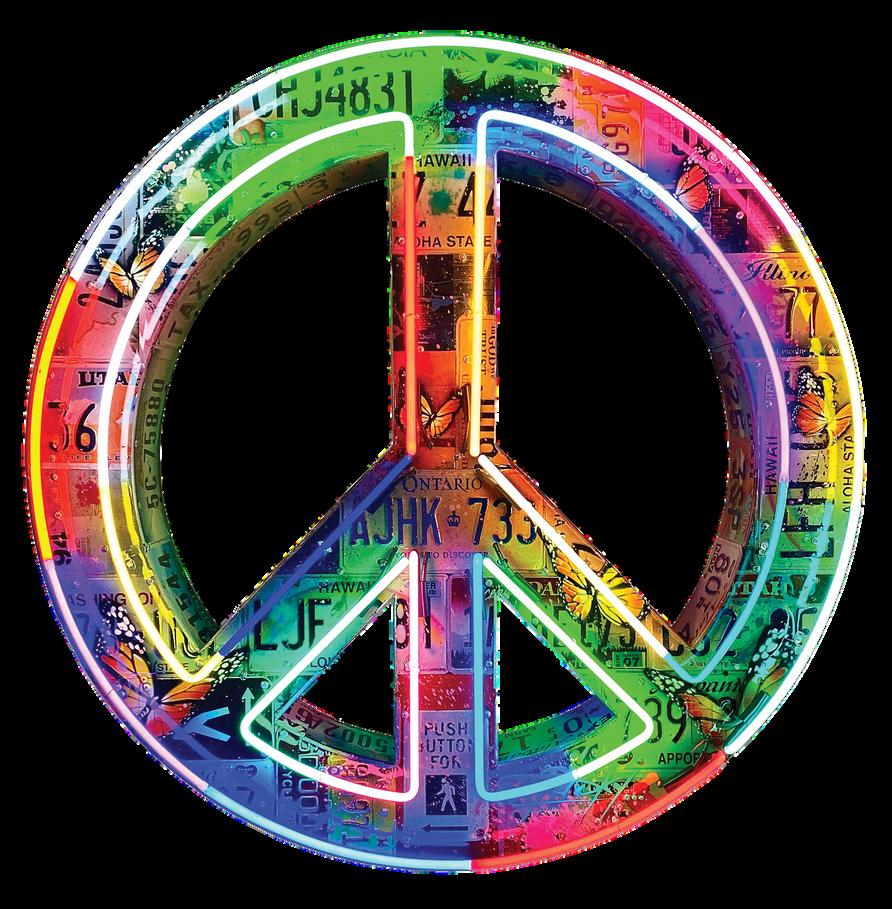
Acrylic, spray paint, kandy car paint, crushed abalone, surfboard resin, and neon on "Metallic Tissue Panel," recycled spray cans and license pates
48 x 48 in
RISK
Risky Felix Neon, 2022
Aerosol, kandy car paint, crushed abalone, surfboard resin, and neon on metallic tissue panel, license plates, road signs, recycled spray can panel 48 x 48 in

RISK
"Keep On Rainbow" Neon, 2022

Acrylic, spray paint, kandy car paint, crushed abalone, surfboard resin, gold-leaf pinstriping, and neon on "Metallic Tissue Panel," recycled license plates
48 x 48 in
RISK
PGFY Finger’ Double-Sided Neon, 2019
Aerosol, kandy car paint, crushed abalone, surfboard resin, and neon on license plate, road signs, recycled spray can panel 60 x 48 x 8 in

RISK
WTF ICON Neon, 2022
Spray paint, acrylic, kandy car paint, crushed abalone, surfboard resin, and neon on "Metallic Tissue Panel," recycled spray cans and license plates
51 x 60 x 4 in

RISK
Walk Through the Valley, 2022

Acrylic, spray paint, kandy car paint, crushed abalone, surfboard resin, copper pennies, and neon on "Metallic Tissue Panel," recycled spray cans and license plates
72 x 48 in
RISK
Old Habits Die Hard, 2017
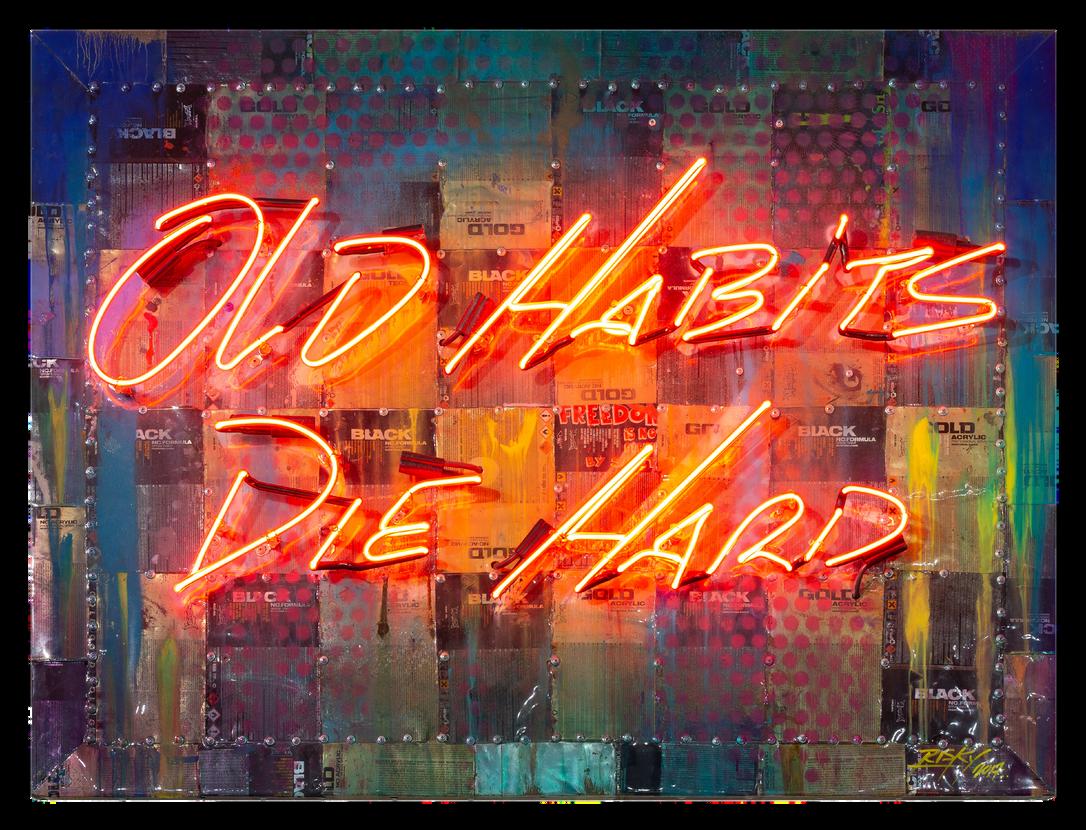
Acrylic, spray paint, kandy car paint, crushed abalone, surfboard resin, copper pennies, and neon on "Metallic Tissue" Panel, recycled spray cans and license plates
36 x 48 in
RISK
Risk Tag, 2022
Acrylic, spray paint, kandy car paint, crushed abalone, surfboard resin, and neon on "Metallic Tissue Panel," recycled spray cans and license plates
108 x 66 in
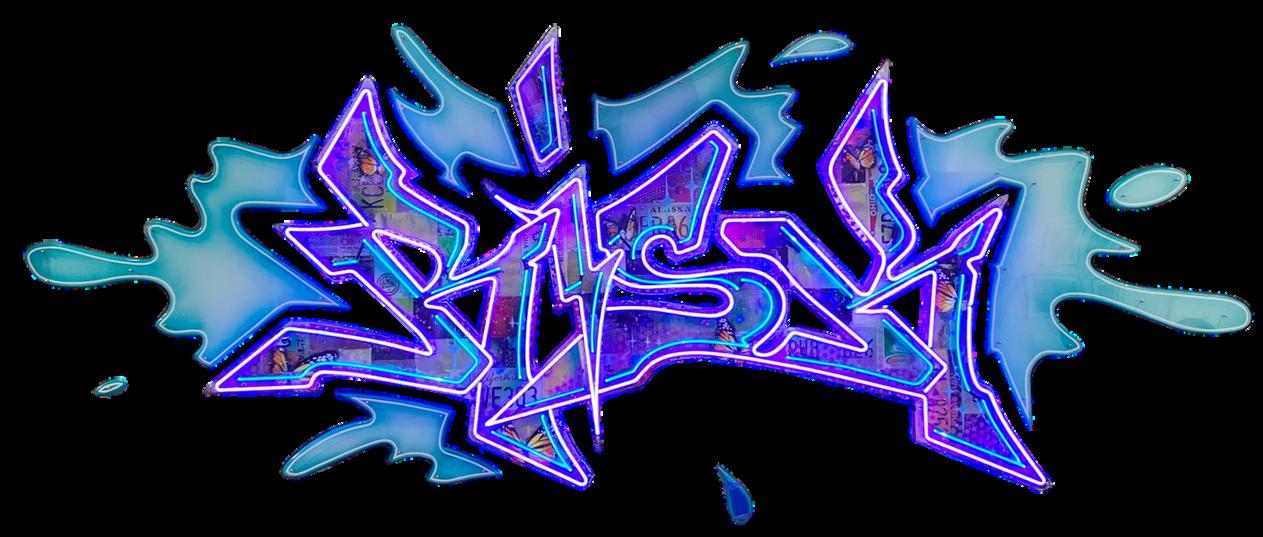
RISK
ROLLING RISKY, 2022
Acrylic, aerosol, kandy car paint, surfboard resin, and neon on "Metallic Tissue" panel
48 x 48 in
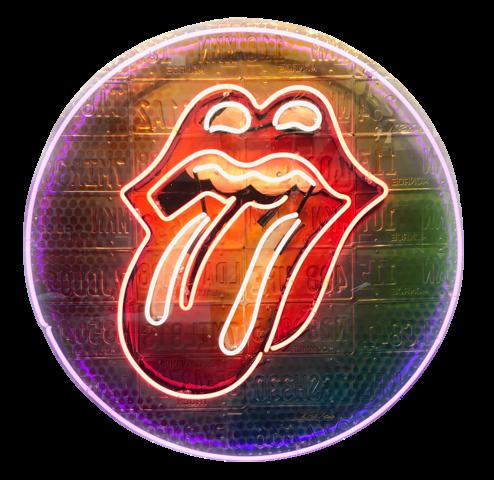
FACE YOUR FEARS
RISK’s Face Your Fears series was inspired by Damien Hirst’s Natural History series and a collection of conversations about Buddhism with the late painter Ed Moses. RISK recalls when Moses introduced him to the concept that the fundamental essence of fear is a feeling of rejection toward suffering. A former surfer, RISK dreaded sharks, compelling him to examine Hirst’s preoccupation with preservation in his Natural History series, particularly Hirst’s infamous The Physical Impossibility of Death in the Mind of Someone Living (1991). RISK built on that foundation and challenged himself to create a series of sculptures inspired by fear. His many large-scale shark sculptures include a massive ten-foot long shark composed of assorted machine materials, as well as a shark built entirely from license plates referencing police as predators. The first sculpture in the series, in fact, was a life-sized LAPD Police Cruiser car intricately cut in half lengthwise. Risk explained “If you are a graffiti artist, the real predators are the police.”
90
RISK
"Face Your Fears" Medium Shark, 2018
Metal found objects sculpture


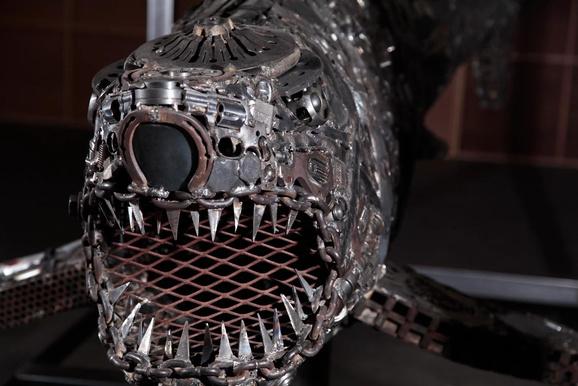
84 x 60 x 120 in

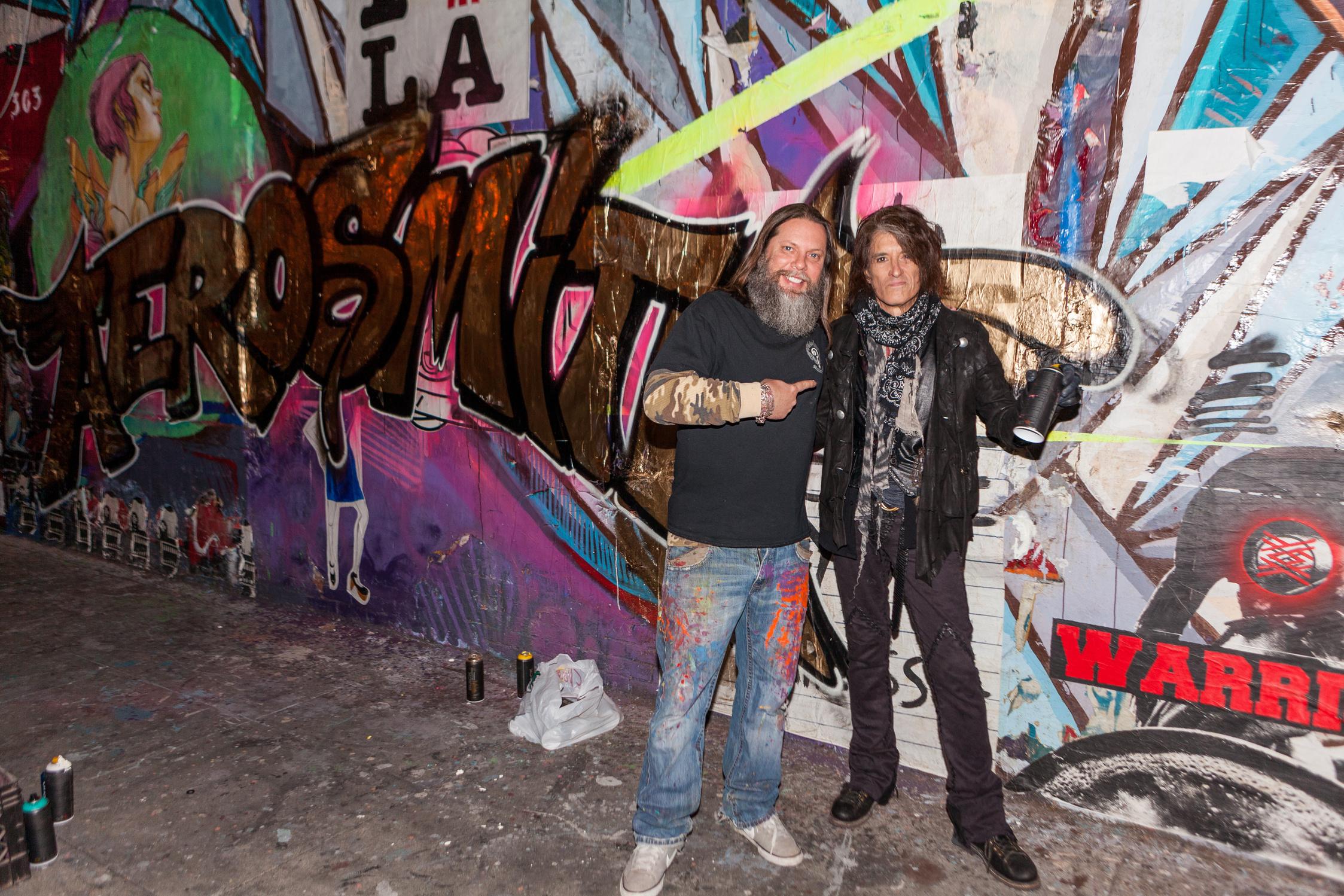
RISK & ROLL
From a very early age, Kelly “RISK” Gravel has had a deep connection to the LA music scene. As a young graffiti writer in LA, RISK would cruise the streets looking for film shoots and ask if the production department needed “real graffiti” for their sets. On one such occasion, a producer asked RISK to cover the entire set for a music video with graffiti That production was the set for Michael Jackson’s 1987 “The Way You Make Me Feel” music video.
RISK has done original work, commissions, and designs for some of the biggest names in the music business including Red Hot Chili Peppers, Slash, Ice Cube, Aerosmith, Bad Religion, House of Pain, Halsey, Cypress Hill, and Blink 182. Joe Perry and Steven Tyler of Aerosmith wrote a special dedication for the RISK book “Old Habits Die Hard," stating “RISK is to art what Aerosmith is to Rock and Roll.” RISK’s two-acre studio and home in Thousand Oaks California is a regular stop for some of the biggest names in music.
RISK’s influence on the music world takes many forms From hosting the first ever live concert by Cypress Hill at his small Hollywood Studio to painting for emerging bands like the “Dirty Heads” or hand painting all on stage outfits for Halsey’s 2019 world concert tour RISK has had the privilege of collaborating on original works with several notable artists including his 2018 collection with legendary lyricist Bernie Taupin and a series of works in 2020 with musician Travis Barker.
The Rolling Stones Logo is another example of RISK’s connection to the biggest names in the music world. Through mutual friends of the Rolling Stones and a chance encounter with the artist who designed the “Stones Tongue Logo” - RISK is one of only a few artists’ in the world with permission to use the iconic logo in his original art.
93
Pictured on left: RISK with Joe Perry, lead vocalist of Aerosmith
RISK
60" Tongue, 2017

Spray paint, kandy car paint, crushed abalone, and
neon on spray can collage panel
60 x 60 in
RISK
Rolling Risky Red, 2022
Acrylic and aerosol on hand-woven Coventry rag

archival paper
54.75 x 51.75 in
RISK
"Rolling Risky Red" Neon, 2022

Acrylic, spray paint, kandy car paint, crushed abalone, surfboard resin, and neon on "Metallic Tissue Panel," recycled license plates
72 x 72 in
RISK
Rolling Risky Red, 2022
Acrylic, spray paint, kandy car paint, crushed abalone, surfboard resin, and neon on "Metallic Tissue Panel," recycled spray cans and license plates
48 x 48 in
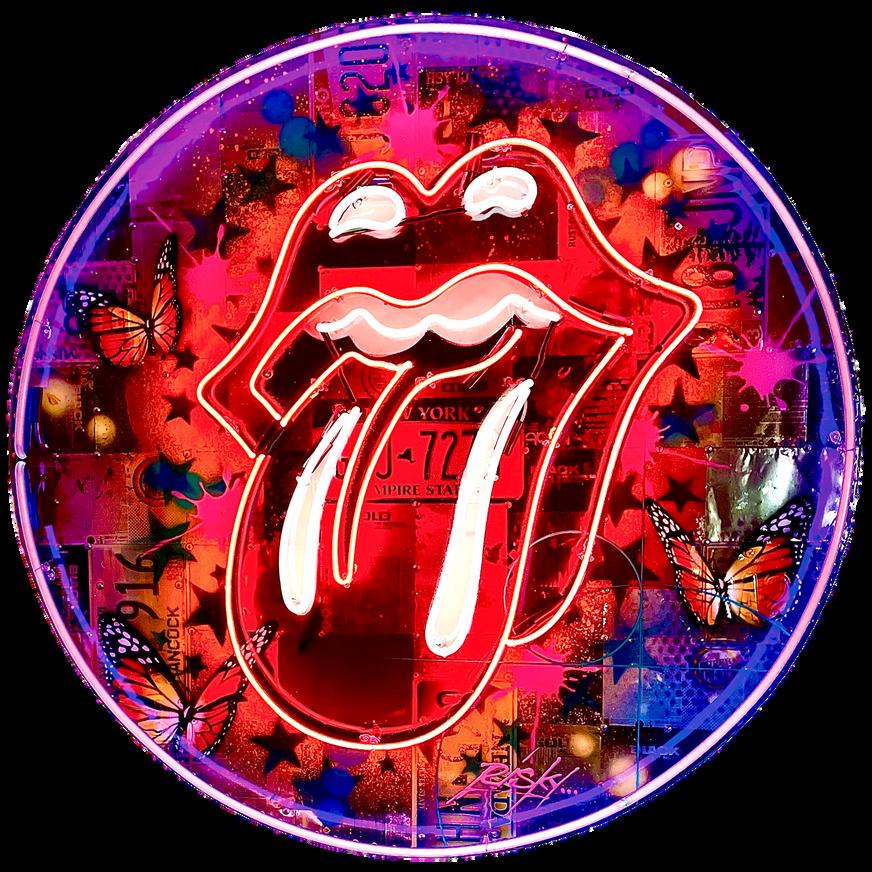
RISK

Risk and Roll, 2022
Fiber glass, spray paint cans, license plates, aerosol, and neon
116 x 41 x 10 in
RISK x Travis Barker
Don't Trust Anyone 3, 2020
Acrylic, spray paint, wheat paste posters, crushed abalone, and surfboard resin on wood panel
24 x 24 in

RISK x Travis Barker
Don't Trust Anyone 6, 2021
Acrylic, spray paint, wheat paste posters, crushed abalone, and surfboard resin on wood panel
36 x 24 in

RISK x Travis Barker
Don't Trust Anyone 30, 2020
Acrylic, spray paint, wheat paste posters, crushed abalone, and surfboard resin on wood panel
30 x 30 in

WCC x ON THE WALL
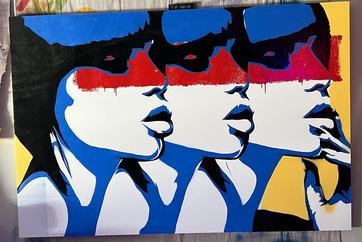

On the Wall is West Chelsea Contemporary's initiative to promote the Austin art community by integrating a curated roster of emerging local talent in each of our exhibitions. For our 9th capsule collection, WCC is excited to present new works by three of our represented artists: Mila Sketch, Bill Tavis, and Matthew Trujillo.

Exhibited alongside Street Kings: Blek Le Rat + RISK, these local artists represent some of the best street artists in Austin who have garnered well-deserved recognition for their bold and unique styles Sketch, Tavis, and Trujillo have each developed practices that engage with the urban environment from public murals to studio canvases.
MILA SKETCH
BILL TAVIS
MATTHEW TRUJILLO

102
American, b. 1985
Mila Sketch is an award-winning artist based in Austin, TX. Sketch’s work leads viewers through a milliard of tiny perfectly connected details to a global & whole mechanism. She works with a set of symbols appealing to the viewer of diverse cultural backgrounds and age groups Mila consistently creates captivating largescale murals, fine art, and digital design. Her work has been exhibited across the United States as well as in Israel, Russia, and the United Kingdom. Sketch has created art for many reputable clients, such as Mazda USA, Google Fiber, SXSW, Hensel Phelps, and Austin-Bergstrom International Airport Mila is currently representing the state of TX in the “Her Flag” 2020 National Art Project.

103
BILL TAVIS

Creating an optical illusion by varying the relative thickness of a repeating pattern, halftone produces the illusion of tonal gradations while only using black and white Tavis’ halftone murals are painted freehand with spray paint Raised in Albuquerque, New Mexico, Tavis was exposed to rich cultural history and fractal vistas, which he cites as an influence on his artistic style. In addition to creating murals and prints, Tavis drew upon his education in animation to create a halftone software to create hundreds of digital halftone artworks Tavis’ animated halftone GIFs have been exhibited in digital art festivals around the world. Tavis lives and works in Austin, TX.
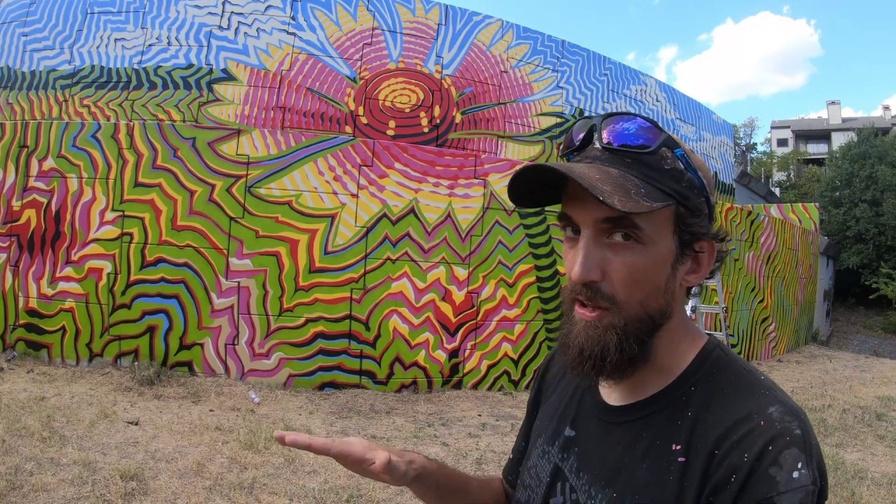
104
MATTHEW TRUJILLO
Born in Las Cruces, New Mexico, 31-year-old working-artist Matthew Trujillo now calls Austin, TX his home. Matthew draws influence from fashion, music, architecture, design, and beyond. His use of sharp, graphic-style facial expressions, mixed with contemporary design creates striking presentations of modern pop art mixed with street style aesthetic. Successfully experimenting with the different light tones that bring more intensity and depth to his painting Trujillo creates mesmerizing art that sparks the imagination of the viewer and invites them to create their own story Having gained a strong following across Texas, Trujillo was featured in the show Concrete to Canvas as a represented artist of HOPE Outdoor Gallery. Following the exhibition, Trujillo was added to West Chelsea Contemporary's represented artist roster

American 105
106
West Chelsea Contemporary is a world-class gallery offering museum-quality art in Austin, Texas, and New York City, focusing on 20th century and contemporary art predominantly in American, Asian, and European post-war movements. West Chelsea Contemporary opened in October of 2020 under the direction of Lisa Russell, who has operated this gallery since founding Russell Collection in 2002. With this gallery rebrand, her vision is for West Chelsea Contemporary to satisfy the evolving demographic and style of Austin’s culture by showcasing everything from mid-career and emerging artists to legends like KAWS, Yayoi Kusama, Keith Haring, Shepard Fairey, Andy Warhol, Blek Le Rat, Mr. Brainwash, Fiona Rae, Roy Lichtenstein, Takashi Murakami and more West Chelsea Contemporary clients are assisted by an expert staff dedicated to providing the highest level of service
NEW
YORK CITY - CHELSEA
231 10th Ave New York, NY 10011
646.590.0352

Monday - Wednesday 10am - 6pm
Thursday - Friday 10am - 8pm
Saturday 10am - 6pm; Sunday 12 - 6pm
AUSTIN - DOWNTOWN
1009 West 6th Street #120 Austin, TX 78703
512.478.4440


Monday - Wednesday 10am - 6pm
Thursday - Friday 10am - 8pm
Saturday 10am - 6pm; Sunday 12 - 6pm
WCC.ART @WCC.ART SALES@WCC.ART
WCC.ART WCCGIFTSHOP.ART

WWW.WCC.ART @WCC.ART SALES@WCC.ART AUSTIN 1009 W 6TH ST #120 AUSTIN, TX 78703 512 478 4440 NEW YORK 231 10TH AVENUE NEW YORK, NY 10011 646 590 0352



























































 Acrylic, aerosol, and crushed abalone on door from Boeing 777 airliner
Acrylic, aerosol, and crushed abalone on door from Boeing 777 airliner

































